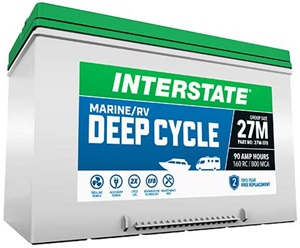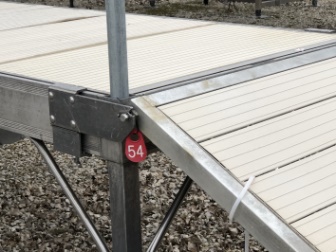Why Is A Lead Acid Battery used?
For years, the battery of choice for boat motors has been the lead-acid type. New technology will someday lower lithium battery prices, and boaters will change over to the latest technologies. In the meantime, boat owners will continue to be stuck with the old, heavy lead-acid batteries we use today.
At this point, they are still the least expensive source of energy available. We have to take care of the battery to get the most out of it and make sure it has enough stored power when we need it. You can’t start your engine or operate the lift motor with a dead battery.
PWS recommends the Interstate deep-cycle Marine Battery line.
We will be discussing boats running 12 and 24-volt battery systems to power a boat or a lift motor in this post.
How do you know if a battery has a full charge?
A fully charged battery, not connected to anything, will read 12.8 volts. A battery at half charge reads 12.2 volts, and a dangerously low unit will read 11.8 volts. It leaves little room for error with readings that close together. Keeping your boat battery charged is vital.
What happens to a less than fully charged battery?
Lead-acid batteries will discharge over time. The damp, cool environment of a boat only accelerates the process. If left in a discharged state, they have a high chance of having permanent damage – at the very least, shortening its lifespan.
Just because there are no moving parts doesn’t mean that it cannot be damaged and fail. Individual cells within a battery may collapse, rendering the entire battery useless.
Some form of charging system is mandatory for every battery. The charging system isn’t just a matter of buying the cheapest, smallest charger from a local auto shop. A charger like that usually won’t make it through the first season in a marine environment.
Like everything else that has to work on your boat, It’s needs to be designed specifically for these conditions. The best brands understand this and make their product accordingly.
A 10 amp charger shoved ten amps into your battery in the old days – whether it needed it or not. If you left it plugged in, you run the risk of ‘cooking’ the cells dry. The water evaporates, and the cells short out.
The advent of “staged” chargers changed all that. The staged chargers (like solar chargers) were designed to be attached 24/7. The chargers cycle through a series of steps that condition the battery and prolong its life. The proper charger will pay for itself the next time you don’t have to replace your batteries.
Trickle Chargers
Trickle chargers are great for motorcycle or jet ski batteries. However, an average-sized boat battery requires extra “Umph” if used frequently. Even the deep cell marine battery needs charging after use. Opinions vary but don’t waste your time with anything less than a 10 amp charger.
WHAT SIZE CHARGER DO I NEED?
Do you have two batteries for operating a lift motor? A regulator will spread the charge between the batteries as each battery becomes fully charged.
As a side note, using (2) deep cell marine batteries will increase the speed of the boat lift mechanism. Sorry, it will increase the speed but not by 2x.
Solar Panels
Solar panels are a completely different discussion. Their progress has been steadily improving efficiency. Each year there are improvements to their performance.
Keeping your Battery Terminals Clean
Keep your batteries clean – particularly the terminals.
There are liquids and sprays to protect your terminals from corrosion. These liquids will also safeguard any connections mounted to the terminals—no more of that nasty green stuff.
Keeping the terminals clean will keep a good flow of electricity to those motors when they need it. These liquids and sprays will also make it easy to remove your batteries should the need arise.
MY MOTOR WON’T START – How do I know if it’s a bad battery connection?
Like a car in the middle of winter, if you get a stuttering sound when trying to start your boat, it means the connections at the battery need cleaning. Continuing to try to start the motor will only draw down the battery power further. Watch for the lights dimming when you try to start the engine. A corroded connection will cause the lights to dim.
SUMMARY
Hopefully, this information gives you a better understanding of batteries and makes your boating life easier and more enjoyable.
Where can you find Pier & Waterfront Solutions?
Pier & Waterfront Solutions, 7325 St. Hwy 57, is located 3 miles south of Sturgeon Bay. Go 1 mile PAST the intersection with County MM (heading north). Look on the right at the intersection of Idlewild Road and Hwy 57.
PWS is
Pier & Waterfront Solutions remains “open” year-round.
The Covid-19 virus is waning. We hope people will continue to get the vaccine to help stop the spread of this deadly virus. We will continue to conduct as much business as possible by email, text, or phone to do our part to keep people safe.
Site visits continue as usual. When making in-person contacts, we follow “social distancing” guidelines when possible by doing any face-to-face contact outdoors.
PWS display yard – OPEN 24-7
PWS‘s display area is always open for you to examine at your leisure. All displays available for sale have a numbered, red tag on them. Want more information on something you saw in our yard? Please reference that number when you inquire.
PWS provides estimates by email to make the process faster, safer, and paperless.
Call, message, or email Jerry with any questions.









